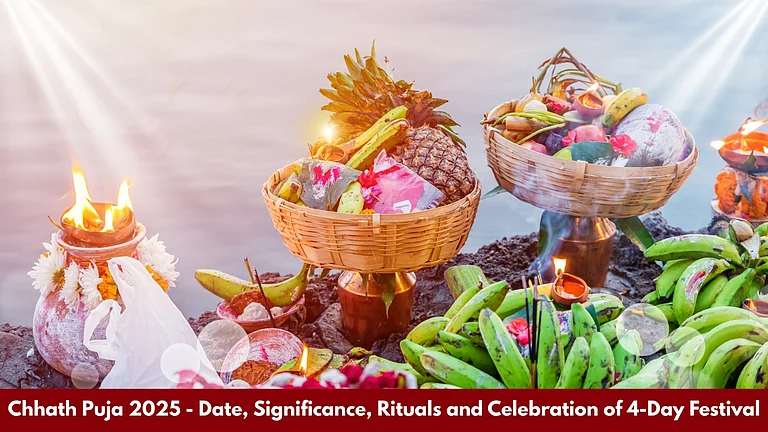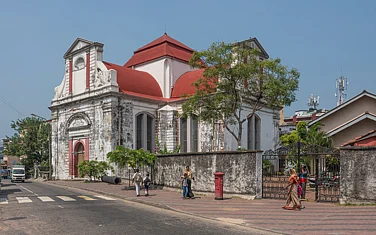The most beloved and purest festival, Chhath, is fast approaching, and with the first day (Nahay-Khay) on November 7, 2024, the devotees of Chhathi Maiya are eagerly waiting to celebrate this four-day festival with great pomp. One of the biggest festivals of Bihar, Jharkhand, Uttar Pradesh, and Nepal is dedicated to the Sun God. Devotees on the first day with Nahay Khay take a holy dip in the river and keep fast for 36 hours. It is observed with utmost devotion and strict rituals, aimed at offering prayers to the Sun God (Surya Dev) and Chhathi Maiya (Mother Goddess of Chhath) for the well-being of family members and to express gratitude for life’s blessings. It is observed with utmost devotion and strict rituals aimed at offering prayers to the Sun God (Surya Dev) and Chhathi Maiya (Mother Goddess of Chhath) for the well-being of family members and to express gratitude for life’s blessings. In this article, we will focus on the Do’s and Don'ts to follow in this biggest festival in India.
When is Chhath Puja 2024: Know the date and timing of the festival
First Day: Nahay Khay (05 November, 2024)
Second Day: Kharna (06 November, 2024)
Third-Day: Chhath Puja Sandhya Arghya starts at 6: 38 AM on November 7, 2024
Fourth Day: Usha Arghya starts at 05:32 PM on 8 November 2024.
Key rituals and important days of Chhath Puja
Nahay Khay (November 5, 2024)

The most important and first day of Chhath puja is the nahay khay, where the devotees bathe in the river or cleanse themselves. They also clean the home and maintain cleanliness in the surroundings. As the name suggests, nahay means bathing or cleaning your body, mind, soul, and surroundings, and khay means eating. Nahay Khay, the first day of Chhath, begins after devotees follow the ritual of cleanliness or bathing in holy water or a pond. Devotees cleanse themselves physically to prepare for the spiritual journey ahead. The entire house undergoes a thorough cleaning during the occasion to ensure its purity and suitability for the rituals. This is essential because cleanliness is a crucial part of worship. After cleaning and bathing, devotees prepare simple Kaddu Bhaat and consume it, and after eating, distribute the prasad (Kaddu Bhaat) to the family members.
Kharna (November 6, 2024)

Taking a daily bath is mandatory for the family members of Chhath Vratis because the festival follows the utmost hygiene and cleanliness. On the second day, Kharna, or Lohanda, is celebrated. On the auspicious day, the devotees observe a full-day fast and focus on internal and external purity. The day concludes after devotees worship the sun god in the evening. Devotees observe a strict fast throughout the day, refraining from even drinking water (nirjala vrat). They spend the day preparing food for the evening's offering called kharna. According to rituals, the food Kharna (a pudding made with jaggery, rice, and milk), fruits, and chapati (whole wheat bread) is first offered to the deity and then shared among family and neighbours. After the evening meal, the devotee begins a 36-hour long fast, without food or water, until the morning of the fourth day.
Sandhya Arghya (November 7, 2024)

The most important day of Chhath Puja is the third day which is the sandhya arghaya day, the day when devotees offer their prayers to the setting sun (Sandhya Arghya). The offerings to the Sun god and Chhathi Maiya include fruits like sugarcane, coconut, and bananas, along with thekuas (a traditional sweet made from wheat flour and jaggery). The prasad is arranged in bamboo baskets or soop (a bamboo winnowing tray). Soops, filled with offerings, is a vital part of the arghya (ritual offerings) and symbolizes the fulfilment of wishes. According to rituals, in the evening, families gather at the banks of rivers or water bodies. Devotees stand in knee-deep water, holding the soop, facing the setting sun. After that, they offer prayers and water (arghya) to the setting sun (Surya god and Chhathi Maiya). This marks the end of the day, symbolizing gratitude for the day’s light and life.
Usha Arghya and Paran (November 8, 2024)

The final day involves offering the second Arghya to the rising sun at dawn. Usha arghya is the last day of Chhath puja fasting, and it concludes with arghya being offered to the rising sun standing in the water, symbolizing a new beginning and seeking blessings for the future. In the morning, when the sun rises, the devotees stand in the water, offering the second arghya, asking for well-being, prosperity, and blessings. This act is the most significant moment of Chhath Puja, representing the renewal of energy and life. The completion of Chhath puja fills the hearts of devotees and their families, also, it leaves a void in the hearts of devotees and people who are celebrating this purest festival. After the morning rituals, devotees break their 36-hour fast by consuming the prasad. This marks the end of the Chhath Puja, and the prasad is distributed among family members, neighbours, and friends. Also, there, is a ritual of sharing prasad, especially thekua, among neighbours, and friends, which makes this festival more lovable and enjoyable. Sharing of prasad is symbolic of spreading prosperity and good fortune to the community.
Do’s for the Chhath Puja Fasting

Maintain cleanliness post-Diwali
Chhath Puja requires intense cleaning, including the body, mind, home, and surroundings during the fasting period. It is mandatory to bathe daily and wear new clothes for the entire four days of the festival.
Thekua prasad is compulsory
One of the most beloved prasads is the Thekua, which is a sweet cookie made from wheat flour, jaggery, coconut, ghee, and flavoured traditional spices like cardamom. Wheat grain is washed and then dried in the sun, which is later used in making prasad. The same must be done on priority for prasad making.
Observe fasting with devotion
Chhath Puja involves rigorous fasting. On Nahay Khay (the first day), fasting begins after consuming a simple meal of rice and vegetables prepared without onion and garlic (Kaddu Bhaat). The fast on the final day, known as Nirjala Vrat, is the most difficult, where the devotee abstains from food and water for over 36 hours. This fast must be observed with full dedication and devotion.
Follow the rituals with precision
Wear traditional clothes while performing any puja or rituals. The rituals of Chhath Puja, including Arghya (offering water to the sun) at sunrise and sunset, must be performed at specific times, and Vratis should follow the steps traditionally. Offering prayers while standing in a river or water body, usually a pond or riverbank, is significant as it symbolises purification.
Family togetherness is compulsory
Although the fast is observed primarily by women (Vratis), the entire family should participate in the preparations and rituals. Family members' presence and support during the four days are considered auspicious and add to the positive energy of the celebration. It is important to maintain peace during the festival or ritual.
Do not eat without offering arghya
Vratis should not eat anything without offering water to the Surya Devta, and women who are observing fast should sleep on the ground.
Don’t do these things during Chhath puja

Avoid onion, garlic, non-vegetarian food and alcohol
During the four days of Chhath Puja, consuming non-vegetarian food, onion, garlic, and alcohol is strictly prohibited. Vratis and family members strictly avoid these foods to maintain the sanctity of the occasion.
Do not use dirty utensils
All utensils used for preparing prasad and offerings should be thoroughly cleaned and reserved for this purpose alone. Using utensils that are not properly cleaned or used for cooking non-vegetarian food is considered impure.
Avoid wearing black clothes
While performing the rituals of Chhath Puja, it is recommended to wear new, traditional, and simple clothing, typically in bright colours. Black, as it is considered inauspicious, should be strictly avoided.
Avoid making prasad in plastic utensils
Do not eat food at the place where prasad is being prepared. It is important to avoid any kind of silver, steel, or plastic utensils used during puja. The prasad should be made only on the earthen stove during the puja.
Chhath is a huge occasion that demands unwavering devotion, purity, and patience. By observing the dos and don’ts, devotees can ensure that their rituals are performed with respect and that they receive the blessings of Surya Dev and Chhathi Maiya. Whether you are fasting or participating in the festivities, keep in mind the significance of purity, dedication, and family bonding during this sacred festival.
The festival holds a crucial place in the hearts of devotees and the people who are involved in this festival. One of the most rigorous fasts kept by the devotees for their family's well-being is considered the purest form of love and their dedication is considered significant. Chhath Puja is a unique festival that blends physical endurance, spiritual devotion, and ecological awareness. Its rituals, followed with great care and dedication, reflect the profound respect that devotees have for the sun and nature. By observing these rituals, devotees not only seek blessings for their personal and family well-being but also express gratitude for the energy that sustains life on earth.
Wish you all a very happy Chhath puja!



























